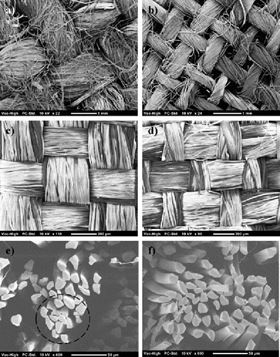 SEM images of the plain weave textiles: (a) flax, (b) hemp, (c) silk A, and (d) silk B. SEM images of cross-sections of silk rovings and fibres in (e) and (f).
SEM images of the plain weave textiles: (a) flax, (b) hemp, (c) silk A, and (d) silk B. SEM images of cross-sections of silk rovings and fibres in (e) and (f).Silk fibers from spiders and silk worms could prove an effective and novel reinforcement in biocomposites, according to research carried out at the University of Oxford.
Many different fibers are used as reinforcing agents in composites, but demands for sustainable materials are spurring interest in natural fibers. Liquid composite and compression molding are the most common manufacturing process, in which reinforcement fibers are arranged in a ‘preform’, a polymer filling agent is introduced, and the two are molded or compressed together. The more compressible the fiber reinforcement, the higher the fiber content that can be achieved in the composite.
Darshil U. Shah and colleagues have found that silk reinforcements are far more compressible than typical plant fibers and even glass fiber textiles [Shah, D. U., et al., Composites: Part A 62 (2014) 1-10, DOI: 10.1016/j.compositesa.2014.03.008]. Unlike plant fibers such as flax and hemp, which typically form bundles, silk from the silkworm Bombyx mori, for example, is created as long, smooth individual threads. These threads or filaments, which can reach up to 1500 m, have almost triangular-shaped cross sections that fit together much more snugly than cylindrical plant fibers.
Textiles woven from silk fibers are much easier to compact than those woven from hemp or flax, according to the study. Comparing silk, hemp, and flax woven textiles in a scanning electron microscope reveals that silk has a much tighter and more ordered weave with much less ‘fluffiness’ or loose, disordered fibers. When it comes to making biocomposites, this means that less compaction pressure is required to achieve a particular fiber volume fraction. For a given compaction pressure, the volume fraction of silk fibers was 10-15% higher than the best flax reinforcement. In fact, silk composites with fiber volume fractions of up to 60% could be produced at low compaction pressures, suggests Shah.
Silk fiber reinforcements have another benefit over plant fibers in that they can withstand bending without breaking better than plant fibers, improving the mechanical performance of the composite. According to the researchers, the findings mean that silk fibers could overcome the bottleneck facing plant fiber reinforcements and enable the manufacture of high fiber-content biocomposites.
“Not only are silk reinforcements significantly more compressible than plant fiber reinforcements, but their compactibility exceeds that of even glass fiber textiles,” explains Shah. “Consequently, silk fiber reinforcements offer a unique opportunity in the production of high fiber volume fraction natural fiber composites.”
Not only would silk-reinforced composites be more sustainable because less energy is required to produce the fibers, but less environmentally unfriendly polymer filler would be needed. Ultimately, these composites could offer better mechanical performance too, particularly where light-weight and high-toughness are required, as well as sustainability.
To download the article related to this news story, please click here.